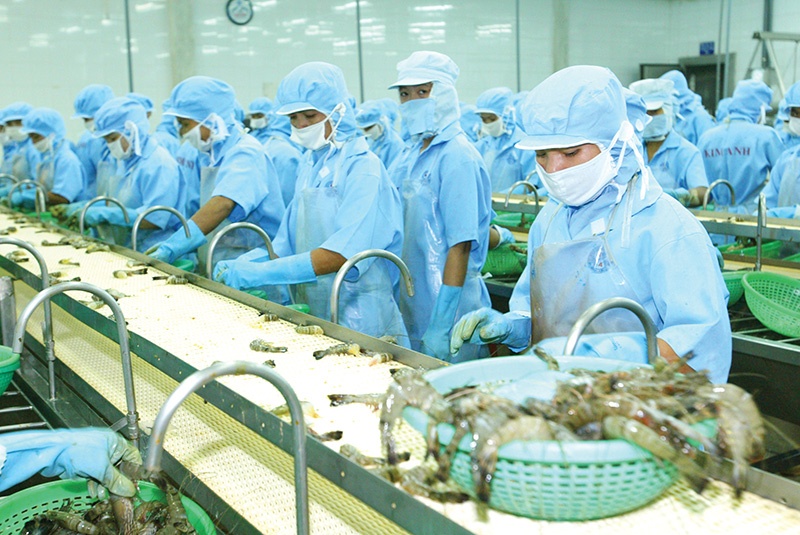Myriad of tough challenges ahead for basa fish producers
 |
| By Truong Dinh Hoe - General secretary Vietnam Association of Seafood Exporters and Producers |
Many businesses suffered under prolonged and strict social distancing as the disease continued to spread throughout provinces. The Mekong Delta has seen disrupted farming, processing, and commodity circulation activities, with supply chains severely disturbed and costs increasing through the stay-at-work model. In addition, the cost of freight increased 8-10 times.
In the third quarter of 2021, basa exports turned over a mere $295 million, down 21 per cent over the same period in the previous year. By the end of November, basa exports only reached $1.4 billion, up just 3.3 per cent over the same period in 2020, and it is expected that the whole year’s growth of the industry in 2021 will also reach 3 per cent, equalling only a sixth of the growth rate of the second quarter.
However, after the tumultuous 2021, businesses have also gained many valuable lessons from adapting to the circumstances. And these experiences will help businesses confidently set higher plans for 2022. Nevertheless, the challenges of 2021 may not be completely solved in 2022.
Healthier market ahead?
Policies to stimulate economic development have tried to cope with high inflation and increased pressure from input and electricity prices which led to increased production costs, coupled with the shortage of labour and a difficult growth of export demand – all of which will still make it difficult for businesses to maintain positive growth.
The Chinese market is forecast to maintain its position as the largest import market for basa fish this year. However, market trends will continue to be affected by the country’s zero-COVID policy during which localities increasingly tighten the control of imported goods at both border and official channels.
As a result, the cross-border exchange is constantly opening and closing, while basa for official export is also facing difficulties because feeder ships entering China via Hong Kong are suspended. In addition, finding containers for exports depends on relationships with shipping lines, agents, and freight rates with skyrocketing surcharges.
Importers also must deal with new import regulations that often mean new costs at the port of destination, as more goods need to be placed in cold storage for pandemic-related checks before being circulated. Thus, the estimated cost for one shipment is now twice as high as in the same period last year.
Chinese restaurants also no longer eagerly accept basa and instead switch to replacing it with domestic fish options. As a result, the export turnover to the Chinese market in the first 11 months of 2021 decreased by 22 per cent to only $376 million.
Likewise, in the EU and UK markets, we cannot expect sudden growth because many of these markets cannot bear the increased price of basa that results from freight rates. The stereotype that basa is a cheap fish also makes it difficult for consumers to pay for increased prices. Thus, even in the UK – the market that saw strong growth in 2020 – basa imports decreased by 23 per cent in 2021, and it will take time for the market’s demand to recover.
The US market considered 2021 a successful year, as it maintained a high growth rate for the whole year, increasing both in volume and export prices. In the first 11 months of 2021, the turnover to this market reached nearly $324 million, up 48 per cent over the same period.
This result is due to the rapid recovery of the US market right after the government reopened the economy and people return to a more-or-less normal life. Thus, the basa demand of the US market in the last six months of 2021 increased significantly, and so did the turnover of this market.
However, at that time, Vietnam’s supply capacity decreased because factories either closed or drastically reduced capacity due. However, this lack is expected to clear up in 2022. It is expected that this year, exports to the US market will be stable.
Other markets such as Mexico, Brazil, Colombia, Russia, and Egypt are expected to return to growth in 2022 and could partially offset the decline in China and Europe. This forecast comes from the results of basa exports in 2021 that saw a double-digit growth rate between 44-84 per cent. The total market share of these five markets accounted for around 16 per cent of domestic export turnover in 2021.
 |
| Seafood exporters have been struggling amid sky-high freight rates and input prices |
Pushed up prices
The price of fish feed remained high in 2021 and increased continuously, thus also raising the price for basa significantly. In addition, low survival rates due to weather put great pressure on fish farmers. The current conditions are also expected to affect the supply of raw materials in 2022. It is forecast that farmed fish production will reach the same equivalent to 2021. While farmers face rising costs, basa export prices are additionally affected by market factors such as transportation charges and controls.
The solution to sustainably develop basa farming in 2022 requires flexibility to cope with the impact of the pandemic, as well as focusing on improving quality to meet the strict demands of the export markets.
The pressure from the unreasonable increase in freight rates in the past time that shows no signs of cooling down is further exacerbating the situation for the entire seafood industry. It is recommended that the government intervenes more deeply and effectively in international freight charges to avoid export disruptions, helping basa-exporting enterprises to be proactive in their production plans for 2022.
Despite all the challenges, the market picture is slowly brightening, based on the adaptation efforts of businesses under the supportive and flexible policies of the government and management agencies. With that optimism in 2022, it is expected that Vietnamese basa exporters will bring in a turnover of $1.7 billion, up 13 per cent compared to 2021.
What the stars mean:
★ Poor ★ ★ Promising ★★★ Good ★★★★ Very good ★★★★★ Exceptional
Related Contents
Latest News
More News
- Financial sector charts next steps as Party Congress convenes (January 21, 2026 | 09:58)
- Three key dynamics supporting Vietnam’s GDP growth in 2026 (January 20, 2026 | 16:34)
- Carlsberg Vietnam and Grab encourage responsible enjoyment and safer mobility (January 16, 2026 | 19:55)
- Redefining Vietnam’s growth model for the era of innovation (January 16, 2026 | 16:40)
- Nghi Son refinery processes first non-Kuwaiti crude cargo (January 16, 2026 | 16:06)
- Siemens and VSIP announce landmark strategic partnership (January 15, 2026 | 14:48)
- VinFast sets record with 175,099 electric vehicles delivered in Vietnam in 2025 (January 15, 2026 | 14:24)
- Year-end shopping season faces rising uncertainty (January 14, 2026 | 18:11)
- State sector sees broad-based profit surge as major groups deliver strong results (January 13, 2026 | 17:34)
- HSBC forecasts Vietnam's GDP growth to hit 6.7 per cent in 2026 (January 13, 2026 | 17:33)

 Tag:
Tag:




















 Mobile Version
Mobile Version